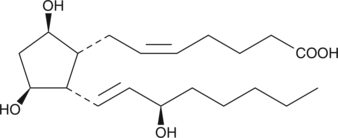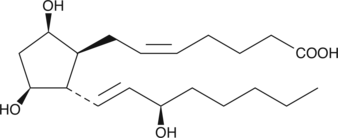Chemicals
Showing 18601–18750 of 41137 results
-
Enclomiphene is an estrogen receptor (ER) modulator.{53931,53932,53933} It acts as an ER antagonist in humans, sheep, and rabbits and an ER agonist in rats.{53931,53932,53933} Enclomiphene (0.34 µM) inhibits binding of 17β-estradiol (E2; Item No. 10006315) in isolated rabbit uterus.{53932} It decreases E2-induced inhibition of follicle stimulating hormone (FSH) secretion in primary sheep pituitary cells in a concentration-dependent manner.{53933} Enclomiphene (0.25 and 0.5 mg/animal) inhibits spermatogenesis and decreases serum luteinizing hormone (LH) and testosterone levels in intact or castrated rats.{53934} Formulations containing enclomiphene have been used in the treatment of ovarian dysfunction.
Brand:CaymanSKU:30965 - 50 mgAvailable on backorder
B-Raf is a MAP kinase kinase kinase, which functions downstream of Ras family GTPases to activate MEK1/2 and ERK1/2 signaling. A mutation of B-Raf in exon 15 at codon 600 where a valine is substituted by glutamic acid (V600E) has been linked to melanoma.{27148} Encorafenib is a selective inhibitor of B-RafV600E mutant melanoma cell proliferation (EC50 = 4 nM) with little activity against wild-type B-Raf or a panel of 100 other kinases (IC50s = 900 nM).{27851} At oral doses of 6 mg/kg in human melanoma xenograft models, encorafenib was shown to decrease phosphorylation of the B-Raf substrate MEK.{27852}
Brand:CaymanSKU:-Out of stock
B-Raf is a MAP kinase kinase kinase, which functions downstream of Ras family GTPases to activate MEK1/2 and ERK1/2 signaling. A mutation of B-Raf in exon 15 at codon 600 where a valine is substituted by glutamic acid (V600E) has been linked to melanoma.{27148} Encorafenib is a selective inhibitor of B-RafV600E mutant melanoma cell proliferation (EC50 = 4 nM) with little activity against wild-type B-Raf or a panel of 100 other kinases (IC50s = 900 nM).{27851} At oral doses of 6 mg/kg in human melanoma xenograft models, encorafenib was shown to decrease phosphorylation of the B-Raf substrate MEK.{27852}
Brand:CaymanSKU:-Out of stock
B-Raf is a MAP kinase kinase kinase, which functions downstream of Ras family GTPases to activate MEK1/2 and ERK1/2 signaling. A mutation of B-Raf in exon 15 at codon 600 where a valine is substituted by glutamic acid (V600E) has been linked to melanoma.{27148} Encorafenib is a selective inhibitor of B-RafV600E mutant melanoma cell proliferation (EC50 = 4 nM) with little activity against wild-type B-Raf or a panel of 100 other kinases (IC50s = 900 nM).{27851} At oral doses of 6 mg/kg in human melanoma xenograft models, encorafenib was shown to decrease phosphorylation of the B-Raf substrate MEK.{27852}
Brand:CaymanSKU:-Out of stock
Endosidin 2 (ES2) is a cell-permeable benzylidene-benzohydrazide that binds to the exocyst component of the 70 kDa (EXO70) subunit of the exocyst complex (Kd = 253 μM, EXO70A1).{38068} ES2 binding inhibits exocytosis and endosomal recycling in plant and mammalian cells. ES2 disrupts protein trafficking between the endosome and plasma membrane, which enhances trafficking to the vacuole for degradation. It also inhibits recycling of endocytosed transferrin to the plasma membrane in HeLa cells and can target multiple isoforms of mammalian EXO70, resulting in misregulation of exocytosis.
Brand:CaymanSKU:21888 -Out of stock
Endosidin 2 (ES2) is a cell-permeable benzylidene-benzohydrazide that binds to the exocyst component of the 70 kDa (EXO70) subunit of the exocyst complex (Kd = 253 μM, EXO70A1).{38068} ES2 binding inhibits exocytosis and endosomal recycling in plant and mammalian cells. ES2 disrupts protein trafficking between the endosome and plasma membrane, which enhances trafficking to the vacuole for degradation. It also inhibits recycling of endocytosed transferrin to the plasma membrane in HeLa cells and can target multiple isoforms of mammalian EXO70, resulting in misregulation of exocytosis.
Brand:CaymanSKU:21888 -Out of stock
Endosidin 2 (ES2) is a cell-permeable benzylidene-benzohydrazide that binds to the exocyst component of the 70 kDa (EXO70) subunit of the exocyst complex (Kd = 253 μM, EXO70A1).{38068} ES2 binding inhibits exocytosis and endosomal recycling in plant and mammalian cells. ES2 disrupts protein trafficking between the endosome and plasma membrane, which enhances trafficking to the vacuole for degradation. It also inhibits recycling of endocytosed transferrin to the plasma membrane in HeLa cells and can target multiple isoforms of mammalian EXO70, resulting in misregulation of exocytosis.
Brand:CaymanSKU:21888 -Out of stock
Endosulfan I is an organochlorine insecticide and a stereoisomer of endosulfan II (Item No. 24254).{39835} It is active against a variety of insects, including bollworms (LD50 = 0.63 mg/g).{39835,39836} Endosulfan I binds to GABA receptors in rat brain membranes with an IC50 value of 30 nM and is toxic to rats (LD50 = 18 mg/kg).{39834}
Brand:CaymanSKU:24253 - 10 mgAvailable on backorder
Endosulfan I is an organochlorine insecticide and a stereoisomer of endosulfan II (Item No. 24254).{39835} It is active against a variety of insects, including bollworms (LD50 = 0.63 mg/g).{39835,39836} Endosulfan I binds to GABA receptors in rat brain membranes with an IC50 value of 30 nM and is toxic to rats (LD50 = 18 mg/kg).{39834}
Brand:CaymanSKU:24253 - 100 mgAvailable on backorder
Endosulfan I is an organochlorine insecticide and a stereoisomer of endosulfan II (Item No. 24254).{39835} It is active against a variety of insects, including bollworms (LD50 = 0.63 mg/g).{39835,39836} Endosulfan I binds to GABA receptors in rat brain membranes with an IC50 value of 30 nM and is toxic to rats (LD50 = 18 mg/kg).{39834}
Brand:CaymanSKU:24253 - 25 mgAvailable on backorder
Endosulfan I is an organochlorine insecticide and a stereoisomer of endosulfan II (Item No. 24254).{39835} It is active against a variety of insects, including bollworms (LD50 = 0.63 mg/g).{39835,39836} Endosulfan I binds to GABA receptors in rat brain membranes with an IC50 value of 30 nM and is toxic to rats (LD50 = 18 mg/kg).{39834}
Brand:CaymanSKU:24253 - 50 mgAvailable on backorder
Endosulfan II is an organochlorine insecticide and a stereoisomer of endosulfan I.{39834} It is active against a variety of insects including bollworms and tobacco budworms (LD50s = 4.14 and 4.95 mg/g, respectively).{39835,39836} Endosulfan II binds to GABA receptors in rat brain membranes with an IC50 value of 60 nM and is less toxic to rats than endosulfan I (LD50s = 240 and 18 mg/kg, respectively).
Brand:CaymanSKU:24254 - 10 mgAvailable on backorder
Endosulfan II is an organochlorine insecticide and a stereoisomer of endosulfan I.{39834} It is active against a variety of insects including bollworms and tobacco budworms (LD50s = 4.14 and 4.95 mg/g, respectively).{39835,39836} Endosulfan II binds to GABA receptors in rat brain membranes with an IC50 value of 60 nM and is less toxic to rats than endosulfan I (LD50s = 240 and 18 mg/kg, respectively).
Brand:CaymanSKU:24254 - 25 mgAvailable on backorder
Endosulfan II is an organochlorine insecticide and a stereoisomer of endosulfan I.{39834} It is active against a variety of insects including bollworms and tobacco budworms (LD50s = 4.14 and 4.95 mg/g, respectively).{39835,39836} Endosulfan II binds to GABA receptors in rat brain membranes with an IC50 value of 60 nM and is less toxic to rats than endosulfan I (LD50s = 240 and 18 mg/kg, respectively).
Brand:CaymanSKU:24254 - 50 mgAvailable on backorder
Endosulfan sulfate is a major metabolite of endosulfan, a broad-spectrum organochlorine insecticide.{36688} Endosulfan sulfate is formed through oxidation of endosulfan by bacteria and fungi in the environment, where it is considered a persistent organic pollutant (POP). It accumulates in the liver and gonads of wild silverside fish (O. bonariensis) and is found in higher amounts in mature fish than pre-spawning fish.{36689} Levels of endosulfan sulfate in the gills of mature O. bonariensis correlate with increased levels of lipid peroxidation. It is toxic to freshwater fish, including G. affinis, H. formosa, P. latipinna, and P. promelas, with LC50 values ranging from 2.1 to 3.5 µg/L after a 96-hour exposure.{36690} Endosulfan sulfate is the main metabolite found in the liver of mice following endosulfan administration at doses of 0.3 and 3 mg/kg.{36691} It decreases the levels of glutathione (GSH) and malondialdehyde (MDA), a product of lipid peroxidation, in the liver, but increases MDA in the kidney when administered at a dose of 3 mg/kg.
Brand:CaymanSKU:24255 - 100 mgAvailable on backorder
Endosulfan sulfate is a major metabolite of endosulfan, a broad-spectrum organochlorine insecticide.{36688} Endosulfan sulfate is formed through oxidation of endosulfan by bacteria and fungi in the environment, where it is considered a persistent organic pollutant (POP). It accumulates in the liver and gonads of wild silverside fish (O. bonariensis) and is found in higher amounts in mature fish than pre-spawning fish.{36689} Levels of endosulfan sulfate in the gills of mature O. bonariensis correlate with increased levels of lipid peroxidation. It is toxic to freshwater fish, including G. affinis, H. formosa, P. latipinna, and P. promelas, with LC50 values ranging from 2.1 to 3.5 µg/L after a 96-hour exposure.{36690} Endosulfan sulfate is the main metabolite found in the liver of mice following endosulfan administration at doses of 0.3 and 3 mg/kg.{36691} It decreases the levels of glutathione (GSH) and malondialdehyde (MDA), a product of lipid peroxidation, in the liver, but increases MDA in the kidney when administered at a dose of 3 mg/kg.
Brand:CaymanSKU:24255 - 50 mgAvailable on backorder
Endothall is an herbicide that is used to control a wide range of terrestrial and aquatic plants. It is a contact herbicide that inhibits translation and induces the production of ethylene in some plants.{30172,30171} Endothall has a half-life of approximately four days in experimental pools.{30173}
Brand:CaymanSKU:-Available on backorder
Endothall is an herbicide that is used to control a wide range of terrestrial and aquatic plants. It is a contact herbicide that inhibits translation and induces the production of ethylene in some plants.{30172,30171} Endothall has a half-life of approximately four days in experimental pools.{30173}
Brand:CaymanSKU:-Available on backorder
Endothall is an herbicide that is used to control a wide range of terrestrial and aquatic plants. It is a contact herbicide that inhibits translation and induces the production of ethylene in some plants.{30172,30171} Endothall has a half-life of approximately four days in experimental pools.{30173}
Brand:CaymanSKU:-Available on backorder
Endothall is an herbicide that is used to control a wide range of terrestrial and aquatic plants. It is a contact herbicide that inhibits translation and induces the production of ethylene in some plants.{30172,30171} Endothall has a half-life of approximately four days in experimental pools.{30173}
Brand:CaymanSKU:-Available on backorder
Enfuvirtide is a biomimetic peptide inhibitor of HIV-1 fusion with CD4+ cells.{36579} It inhibits HIV-1 infectivity of HeLa cells stably expressing CD4 by the HXB2 strain (IC50 = 692 pM) and by clinical isolates (IC90s = 6.1-61 nM) in a single-cycle infectivity assay. It also inhibits genomic integration of HIV-1 into human intraepithelial vaginal cells and peripheral blood mononuclear cells (PBMCs; IC50s = 51.2 and 13.58 μM, respectively).{36580} Enfuvirtide binds to a recombinant molecular mimic of HIV-1 glycoprotein gp41 that contains three N-terminal heptad and two C-terminal heptad repeat regions (Kd = 32 nM).{36581} It also binds to recombinant formyl peptide receptors (FPR) expressed in rat basophilic leukemia cells (IC50 = 5 nM) and attracts and activates human peripheral blood phagocytes, but not T lymphocytes, in vitro when used at a concentration of 100 nM.{36582} Formulations containing enfuvirtide have been used in combination therapy for the treatment of HIV-1/AIDS.
Brand:CaymanSKU:24097 - 1 mgAvailable on backorder
Enfuvirtide is a biomimetic peptide inhibitor of HIV-1 fusion with CD4+ cells.{36579} It inhibits HIV-1 infectivity of HeLa cells stably expressing CD4 by the HXB2 strain (IC50 = 692 pM) and by clinical isolates (IC90s = 6.1-61 nM) in a single-cycle infectivity assay. It also inhibits genomic integration of HIV-1 into human intraepithelial vaginal cells and peripheral blood mononuclear cells (PBMCs; IC50s = 51.2 and 13.58 μM, respectively).{36580} Enfuvirtide binds to a recombinant molecular mimic of HIV-1 glycoprotein gp41 that contains three N-terminal heptad and two C-terminal heptad repeat regions (Kd = 32 nM).{36581} It also binds to recombinant formyl peptide receptors (FPR) expressed in rat basophilic leukemia cells (IC50 = 5 nM) and attracts and activates human peripheral blood phagocytes, but not T lymphocytes, in vitro when used at a concentration of 100 nM.{36582} Formulations containing enfuvirtide have been used in combination therapy for the treatment of HIV-1/AIDS.
Brand:CaymanSKU:24097 - 10 mgAvailable on backorder
Enfuvirtide is a biomimetic peptide inhibitor of HIV-1 fusion with CD4+ cells.{36579} It inhibits HIV-1 infectivity of HeLa cells stably expressing CD4 by the HXB2 strain (IC50 = 692 pM) and by clinical isolates (IC90s = 6.1-61 nM) in a single-cycle infectivity assay. It also inhibits genomic integration of HIV-1 into human intraepithelial vaginal cells and peripheral blood mononuclear cells (PBMCs; IC50s = 51.2 and 13.58 μM, respectively).{36580} Enfuvirtide binds to a recombinant molecular mimic of HIV-1 glycoprotein gp41 that contains three N-terminal heptad and two C-terminal heptad repeat regions (Kd = 32 nM).{36581} It also binds to recombinant formyl peptide receptors (FPR) expressed in rat basophilic leukemia cells (IC50 = 5 nM) and attracts and activates human peripheral blood phagocytes, but not T lymphocytes, in vitro when used at a concentration of 100 nM.{36582} Formulations containing enfuvirtide have been used in combination therapy for the treatment of HIV-1/AIDS.
Brand:CaymanSKU:24097 - 5 mgAvailable on backorder
Eniporide is a selective inhibitor of human Na+/H+ exchanger isoform 1 (NHE-1) (IC50 = 4.5 nM).{34581} Inhibition with eniporide prevents calcium overload-induced myocardial ischemia-reperfusion injury in vitro and in vivo.{34582,22706,34583,34584}
Brand:CaymanSKU:20984 -Out of stock
Eniporide is a selective inhibitor of human Na+/H+ exchanger isoform 1 (NHE-1) (IC50 = 4.5 nM).{34581} Inhibition with eniporide prevents calcium overload-induced myocardial ischemia-reperfusion injury in vitro and in vivo.{34582,22706,34583,34584}
Brand:CaymanSKU:20984 -Out of stock
Eniporide is a selective inhibitor of human Na+/H+ exchanger isoform 1 (NHE-1) (IC50 = 4.5 nM).{34581} Inhibition with eniporide prevents calcium overload-induced myocardial ischemia-reperfusion injury in vitro and in vivo.{34582,22706,34583,34584}
Brand:CaymanSKU:20984 -Out of stock
Eniporide is a selective inhibitor of human Na+/H+ exchanger isoform 1 (NHE-1) (IC50 = 4.5 nM).{34581} Inhibition with eniporide prevents calcium overload-induced myocardial ischemia-reperfusion injury in vitro and in vivo.{34582,22706,34583,34584}
Brand:CaymanSKU:20984 -Out of stock
ENMD-2076 is a multi-kinase inhibitor that inhibits FMS-related tyrosine kinase 3 (FLT3), RET, and Aurora A kinase with IC50 values of 1.86, 10.4, and 14 nM, respectively.{39604} It inhibits additional kinases involved in angiogenesis such as VEGFR3, PDGFRα, and FGFR2, among others, with IC50 values of less than 100 nM. It inhibits proliferation of several human triple-negative breast cancer (TNBC) cell lines with IC50 values of less than 1 µM, halts the cell cycle at the G2 phase, and induces apoptosis.{39603} Oral administration of ENMD-2076 (200 mg/kg), reduces proliferation, enhances p53- and p73-mediated cancer cell apoptosis and senescence, and inhibits growth of sensitive primary tumors in a TNBC mouse xenograft model.{39605} It also decreases tumor vascular permeability and perfusion and inhibits tumor growth in human TNBC and colorectal cancer mouse xenograft models when administered orally at a dose of 100 mg/kg.{39603,39606}
Brand:CaymanSKU:22956 - 1 mgAvailable on backorder
ENMD-2076 is a multi-kinase inhibitor that inhibits FMS-related tyrosine kinase 3 (FLT3), RET, and Aurora A kinase with IC50 values of 1.86, 10.4, and 14 nM, respectively.{39604} It inhibits additional kinases involved in angiogenesis such as VEGFR3, PDGFRα, and FGFR2, among others, with IC50 values of less than 100 nM. It inhibits proliferation of several human triple-negative breast cancer (TNBC) cell lines with IC50 values of less than 1 µM, halts the cell cycle at the G2 phase, and induces apoptosis.{39603} Oral administration of ENMD-2076 (200 mg/kg), reduces proliferation, enhances p53- and p73-mediated cancer cell apoptosis and senescence, and inhibits growth of sensitive primary tumors in a TNBC mouse xenograft model.{39605} It also decreases tumor vascular permeability and perfusion and inhibits tumor growth in human TNBC and colorectal cancer mouse xenograft models when administered orally at a dose of 100 mg/kg.{39603,39606}
Brand:CaymanSKU:22956 - 10 mgAvailable on backorder
ENMD-2076 is a multi-kinase inhibitor that inhibits FMS-related tyrosine kinase 3 (FLT3), RET, and Aurora A kinase with IC50 values of 1.86, 10.4, and 14 nM, respectively.{39604} It inhibits additional kinases involved in angiogenesis such as VEGFR3, PDGFRα, and FGFR2, among others, with IC50 values of less than 100 nM. It inhibits proliferation of several human triple-negative breast cancer (TNBC) cell lines with IC50 values of less than 1 µM, halts the cell cycle at the G2 phase, and induces apoptosis.{39603} Oral administration of ENMD-2076 (200 mg/kg), reduces proliferation, enhances p53- and p73-mediated cancer cell apoptosis and senescence, and inhibits growth of sensitive primary tumors in a TNBC mouse xenograft model.{39605} It also decreases tumor vascular permeability and perfusion and inhibits tumor growth in human TNBC and colorectal cancer mouse xenograft models when administered orally at a dose of 100 mg/kg.{39603,39606}
Brand:CaymanSKU:22956 - 5 mgAvailable on backorder
Enniatins are cyclohexadepsipeptides commonly isolated from fungi that are known to have antibiotic properties and to induce apoptosis in several cancer lines.{24952} Many function as ionophores, forming pores in cellular membranes to allow selective ion transport.{24952,24954} Enniatin A is one of four major analogs in the enniatin complex (Item No. 9002040). It has been shown to moderately inhibit acyl-CoA:cholesterol acyltranferase activity in rat liver microsomes with an IC50 value of 22 µM.{24950} Enniatin A also demonstrates anthelmintic properties against N. brasiliensis, T. spiralis, and H. spumosa.{24952}
Brand:CaymanSKU:-Available on backorder
Enniatins are cyclohexadepsipeptides commonly isolated from fungi that are known to have antibiotic properties and to induce apoptosis in several cancer lines.{24952} Many function as ionophores, forming pores in cellular membranes to allow selective ion transport.{24952,24954} Enniatin A is one of four major analogs in the enniatin complex (Item No. 9002040). It has been shown to moderately inhibit acyl-CoA:cholesterol acyltranferase activity in rat liver microsomes with an IC50 value of 22 µM.{24950} Enniatin A also demonstrates anthelmintic properties against N. brasiliensis, T. spiralis, and H. spumosa.{24952}
Brand:CaymanSKU:-Available on backorder
Enniatins are cyclohexadepsipeptides commonly isolated from fungi that are known to have antibiotic properties and to induce apoptosis in several cancer lines.{24952} Many function as ionophores, forming pores in cellular membranes to allow selective ion transport.{24952,24954} Enniatin A1 is one of four major analogs in the enniatin complex (Item No. 9002040 class). Its ionophoric activity has been described.{24954} Additionally, enniatin A1 has been found to induce apoptosis in cancer cells (EC50 = 5 µM in H4IIE rat hepatoma cells), decreasing the activation of the cell proliferation kinase, ERK (p44/p42) and inhibiting TNF-α-induced NF-κB activation.{24949}
Brand:CaymanSKU:-Available on backorder
Enniatins are cyclohexadepsipeptides commonly isolated from fungi that are known to have antibiotic properties and to induce apoptosis in several cancer lines.{24952} Many function as ionophores, forming pores in cellular membranes to allow selective ion transport.{24952,24954} Enniatin A1 is one of four major analogs in the enniatin complex (Item No. 9002040 class). Its ionophoric activity has been described.{24954} Additionally, enniatin A1 has been found to induce apoptosis in cancer cells (EC50 = 5 µM in H4IIE rat hepatoma cells), decreasing the activation of the cell proliferation kinase, ERK (p44/p42) and inhibiting TNF-α-induced NF-κB activation.{24949}
Brand:CaymanSKU:-Available on backorder
Enniatins are cyclichexadepsipeptides commonly isolated from fungi. Many act as ionophores, forming pores in cellular membranes to allow selective ion transport.{24952} Enniatin B is a relatively poor ionophore with some capacity to facilitate import of K+ and Na+ across membranes.{24954} It inhibits the pleiotropic drug resistance protein 5 (Pdr5p) in yeast.{24951} Through this mechanism enniatin B, at concentrations as low as 0.8 μM, augments the ability of cerulenin (Item No. 10005647) or cycloheximide (Item No. 14126) to impair cell proliferation in cells overexpressing Pdr5p, an effect that is not observed in cells lacking Pdr5p.{24951} Like other enniatins, enniatin B inhibits acyl-CoA: cholesterol acyltransferase (IC50 = 113 μM), blocking cholesteryl ester formation.{24950} Enniatin B (1 μM) also increases caspase activity and induces apoptosis in H4IIE hepatoma cells and, when mixed with other enniatins, alters p53 signaling in human cancer cells.{24949,24953}
Brand:CaymanSKU:-Enniatins are cyclichexadepsipeptides commonly isolated from fungi. Many act as ionophores, forming pores in cellular membranes to allow selective ion transport.{24952} Enniatin B is a relatively poor ionophore with some capacity to facilitate import of K+ and Na+ across membranes.{24954} It inhibits the pleiotropic drug resistance protein 5 (Pdr5p) in yeast.{24951} Through this mechanism enniatin B, at concentrations as low as 0.8 μM, augments the ability of cerulenin (Item No. 10005647) or cycloheximide (Item No. 14126) to impair cell proliferation in cells overexpressing Pdr5p, an effect that is not observed in cells lacking Pdr5p.{24951} Like other enniatins, enniatin B inhibits acyl-CoA: cholesterol acyltransferase (IC50 = 113 μM), blocking cholesteryl ester formation.{24950} Enniatin B (1 μM) also increases caspase activity and induces apoptosis in H4IIE hepatoma cells and, when mixed with other enniatins, alters p53 signaling in human cancer cells.{24949,24953}
Brand:CaymanSKU:-Enniatins are cyclohexadepsipeptides commonly isolated from fungi and are known to have antibiotic properties. Many act as ionophores, forming pores in cellular membranes to allow selective ion transport.{24952,24954} Enniatin B1 is one of four major analogs of the enniatin complex (Item No. 9002040). It has been shown to induce apoptosis in several cancer lines (EC50s ≤ 10 µM) and to decrease the activation of the cell proliferation kinase, ERK (p44/p42).{24949} Enniatin B1 also inhibits the multi-drug resistance transporter Pdr5p from S. cerevisiae and has been used to examine drug resistance mechanisms.{24951}
Brand:CaymanSKU:-Out of stock
Enniatins are cyclohexadepsipeptides commonly isolated from fungi and are known to have antibiotic properties. Many act as ionophores, forming pores in cellular membranes to allow selective ion transport.{24952,24954} Enniatin B1 is one of four major analogs of the enniatin complex (Item No. 9002040). It has been shown to induce apoptosis in several cancer lines (EC50s ≤ 10 µM) and to decrease the activation of the cell proliferation kinase, ERK (p44/p42).{24949} Enniatin B1 also inhibits the multi-drug resistance transporter Pdr5p from S. cerevisiae and has been used to examine drug resistance mechanisms.{24951}
Brand:CaymanSKU:-Out of stock
Enniatin complex is a mixture of cyclohexadepsipeptides, commonly isolated from fungi, that act as ionophores, forming pores in cellular membranes to allow selective ion transport.{24952,24954} The complex typically contains the major components: A (Item No. 17456), A1 (Item No. 17457), B (Item No. 15382), and B1 (Item No. 17245) together with minor amounts of enniatin C, D, E, and F.{24952} Enniatins exhibit antimicrobial activity against a variety of eukaryotic and prokaryotic genera, inhibit acyl-CoA:cholesterol acyltranferase, and induce apoptosis in several cancer lines.{24952,24950,24949,24953,24951}
Brand:CaymanSKU:9002040 - 10 mgAvailable on backorder
Enniatin complex is a mixture of cyclohexadepsipeptides, commonly isolated from fungi, that act as ionophores, forming pores in cellular membranes to allow selective ion transport.{24952,24954} The complex typically contains the major components: A (Item No. 17456), A1 (Item No. 17457), B (Item No. 15382), and B1 (Item No. 17245) together with minor amounts of enniatin C, D, E, and F.{24952} Enniatins exhibit antimicrobial activity against a variety of eukaryotic and prokaryotic genera, inhibit acyl-CoA:cholesterol acyltranferase, and induce apoptosis in several cancer lines.{24952,24950,24949,24953,24951}
Brand:CaymanSKU:9002040 - 50 mgAvailable on backorder
Enopeptin A, originally isolated from a culture broth of Streptomyces sp. RK-1051, is a depsipeptide antibiotic that contains two unusual amino acids (N-methylalanine and 4-methylproline) and features a pentaenone side chain.{27772,27773} It is effective against Gram-positive bacteria, including methicillin-resistant S. aureus (MIC = 25 µg/ml), and Gram-negative bacteria, including mutant forms of E. coli and P. aeruginosa (MICs = 200 µg/ml); however, it is not inhibitory to fungi.{27772}
Brand:CaymanSKU:-Out of stock
Enopeptin A, originally isolated from a culture broth of Streptomyces sp. RK-1051, is a depsipeptide antibiotic that contains two unusual amino acids (N-methylalanine and 4-methylproline) and features a pentaenone side chain.{27772,27773} It is effective against Gram-positive bacteria, including methicillin-resistant S. aureus (MIC = 25 µg/ml), and Gram-negative bacteria, including mutant forms of E. coli and P. aeruginosa (MICs = 200 µg/ml); however, it is not inhibitory to fungi.{27772}
Brand:CaymanSKU:-Out of stock
Enoxacin is a fluoroquinolone that prevents bacterial growth by interfering with DNA replication, inhibiting bacterial DNA gyrase (IC50 = 126 µg/ml) and topoisomerase IV (IC50 = 26.5 µg/ml).{27493} It demonstrates broad-spectrum antibacterial activity against many Gram-positive and Gram-negative bacteria.{27493} Its ability to bind to TAR RNA-binding protein 2, a microRNA biosynthesis protein, has been used to enhance the production of microRNAs with tumor suppressor functions to generate tumor-specific growth inhibitory effects in cancer models.{27668}
Brand:CaymanSKU:-Out of stock
Enoxacin is a fluoroquinolone that prevents bacterial growth by interfering with DNA replication, inhibiting bacterial DNA gyrase (IC50 = 126 µg/ml) and topoisomerase IV (IC50 = 26.5 µg/ml).{27493} It demonstrates broad-spectrum antibacterial activity against many Gram-positive and Gram-negative bacteria.{27493} Its ability to bind to TAR RNA-binding protein 2, a microRNA biosynthesis protein, has been used to enhance the production of microRNAs with tumor suppressor functions to generate tumor-specific growth inhibitory effects in cancer models.{27668}
Brand:CaymanSKU:-Out of stock
Enoxacin is a fluoroquinolone that prevents bacterial growth by interfering with DNA replication, inhibiting bacterial DNA gyrase (IC50 = 126 µg/ml) and topoisomerase IV (IC50 = 26.5 µg/ml).{27493} It demonstrates broad-spectrum antibacterial activity against many Gram-positive and Gram-negative bacteria.{27493} Its ability to bind to TAR RNA-binding protein 2, a microRNA biosynthesis protein, has been used to enhance the production of microRNAs with tumor suppressor functions to generate tumor-specific growth inhibitory effects in cancer models.{27668}
Brand:CaymanSKU:-Out of stock
Enoximone is a phosphodiesterase 3 (PDE3) inhibitor (IC50 = 5.9 µM).{56134} It is selective for PDE3 over PDE1, -2, and -4 (IC50s = 2,100, 2,900, and 21.1 µM, respectively). Enoximone increases the force of contraction and cAMP levels in isolated canine right ventricular trabeculae, an effect that can be reversed by carbamoylcholine (carbachol; Item No. 14486).{56135} In vivo, enoximone (0.1-1 mg/kg) increases cardiac contractile force in dogs.{56136} Formulations containing enoximone have been used in the treatment of congestive heart failure.
Brand:CaymanSKU:30868 - 1 mgAvailable on backorder
Enoximone is a phosphodiesterase 3 (PDE3) inhibitor (IC50 = 5.9 µM).{56134} It is selective for PDE3 over PDE1, -2, and -4 (IC50s = 2,100, 2,900, and 21.1 µM, respectively). Enoximone increases the force of contraction and cAMP levels in isolated canine right ventricular trabeculae, an effect that can be reversed by carbamoylcholine (carbachol; Item No. 14486).{56135} In vivo, enoximone (0.1-1 mg/kg) increases cardiac contractile force in dogs.{56136} Formulations containing enoximone have been used in the treatment of congestive heart failure.
Brand:CaymanSKU:30868 - 10 mgAvailable on backorder
Enoximone is a phosphodiesterase 3 (PDE3) inhibitor (IC50 = 5.9 µM).{56134} It is selective for PDE3 over PDE1, -2, and -4 (IC50s = 2,100, 2,900, and 21.1 µM, respectively). Enoximone increases the force of contraction and cAMP levels in isolated canine right ventricular trabeculae, an effect that can be reversed by carbamoylcholine (carbachol; Item No. 14486).{56135} In vivo, enoximone (0.1-1 mg/kg) increases cardiac contractile force in dogs.{56136} Formulations containing enoximone have been used in the treatment of congestive heart failure.
Brand:CaymanSKU:30868 - 5 mgAvailable on backorder
ENPP1 inhibitor C is an inhibitor of ectonucleotide pyrophosphatase/phosphodiesterase 1 (ENPP1; IC50 = 0.26 µM in a cell-free assay).{50634} It is selective for ENPP1 over ENPP2-7 at 10 µM. ENPP1 inhibitor C decreases ENPP1 activity in MDA-MB-231 human breast and C6 rat glioma cancer cells when used at a concentration of 10 µM.
Brand:CaymanSKU:29809 - 1 mgAvailable on backorder
ENPP1 inhibitor C is an inhibitor of ectonucleotide pyrophosphatase/phosphodiesterase 1 (ENPP1; IC50 = 0.26 µM in a cell-free assay).{50634} It is selective for ENPP1 over ENPP2-7 at 10 µM. ENPP1 inhibitor C decreases ENPP1 activity in MDA-MB-231 human breast and C6 rat glioma cancer cells when used at a concentration of 10 µM.
Brand:CaymanSKU:29809 - 10 mgAvailable on backorder
ENPP1 inhibitor C is an inhibitor of ectonucleotide pyrophosphatase/phosphodiesterase 1 (ENPP1; IC50 = 0.26 µM in a cell-free assay).{50634} It is selective for ENPP1 over ENPP2-7 at 10 µM. ENPP1 inhibitor C decreases ENPP1 activity in MDA-MB-231 human breast and C6 rat glioma cancer cells when used at a concentration of 10 µM.
Brand:CaymanSKU:29809 - 25 mgAvailable on backorder
ENPP1 inhibitor C is an inhibitor of ectonucleotide pyrophosphatase/phosphodiesterase 1 (ENPP1; IC50 = 0.26 µM in a cell-free assay).{50634} It is selective for ENPP1 over ENPP2-7 at 10 µM. ENPP1 inhibitor C decreases ENPP1 activity in MDA-MB-231 human breast and C6 rat glioma cancer cells when used at a concentration of 10 µM.
Brand:CaymanSKU:29809 - 5 mgAvailable on backorder
ENPP1-IN-1 is an inhibitor of ectonucleotide pyrophosphatase/phosphodiesterase 1 (ENPP1).{54557} It inhibits the hydrolysis of 2’3’-cGAMP (Item No. 19887) and the ATP analog p-nitrophenyl 5’-adenosine monophosphate (AMP-pNP; Kis = ≤100 and 100-1,000 nM, respectively, in enzyme assays). ENPP1-IN-1 enhances transcription of the gene encoding IFN-β in 2’3’-cGAMP-stimulated human foreskin fibroblast cells (HFF-1) in a concentration-dependent manner.
Brand:CaymanSKU:31764 - 10 mgAvailable on backorder
ENPP1-IN-1 is an inhibitor of ectonucleotide pyrophosphatase/phosphodiesterase 1 (ENPP1).{54557} It inhibits the hydrolysis of 2’3’-cGAMP (Item No. 19887) and the ATP analog p-nitrophenyl 5’-adenosine monophosphate (AMP-pNP; Kis = ≤100 and 100-1,000 nM, respectively, in enzyme assays). ENPP1-IN-1 enhances transcription of the gene encoding IFN-β in 2’3’-cGAMP-stimulated human foreskin fibroblast cells (HFF-1) in a concentration-dependent manner.
Brand:CaymanSKU:31764 - 25 mgAvailable on backorder
ENPP1-IN-1 is an inhibitor of ectonucleotide pyrophosphatase/phosphodiesterase 1 (ENPP1).{54557} It inhibits the hydrolysis of 2’3’-cGAMP (Item No. 19887) and the ATP analog p-nitrophenyl 5’-adenosine monophosphate (AMP-pNP; Kis = ≤100 and 100-1,000 nM, respectively, in enzyme assays). ENPP1-IN-1 enhances transcription of the gene encoding IFN-β in 2’3’-cGAMP-stimulated human foreskin fibroblast cells (HFF-1) in a concentration-dependent manner.
Brand:CaymanSKU:31764 - 5 mgAvailable on backorder
ENPP1-IN-1 is an inhibitor of ectonucleotide pyrophosphatase/phosphodiesterase 1 (ENPP1).{54557} It inhibits the hydrolysis of 2’3’-cGAMP (Item No. 19887) and the ATP analog p-nitrophenyl 5’-adenosine monophosphate (AMP-pNP; Kis = ≤100 and 100-1,000 nM, respectively, in enzyme assays). ENPP1-IN-1 enhances transcription of the gene encoding IFN-β in 2’3’-cGAMP-stimulated human foreskin fibroblast cells (HFF-1) in a concentration-dependent manner.
Brand:CaymanSKU:31764 - 50 mgAvailable on backorder
Enrofloxacin is a broad-spectrum fluoroquinolone antibiotic that is used primarily in veterinary medicine.{32425,32426} It inhibits bacterial DNA gyrase.{32427} Enrofloxacin displays high bioavailability in most species and rapid absorption after oral, intramuscular, or subcutaneous administration.{32426} It has broad distribution in the animal, excellent tissue penetration, and a long serum half-life.{32426}
Brand:CaymanSKU:20301 -Available on backorder
Enrofloxacin is a broad-spectrum fluoroquinolone antibiotic that is used primarily in veterinary medicine.{32425,32426} It inhibits bacterial DNA gyrase.{32427} Enrofloxacin displays high bioavailability in most species and rapid absorption after oral, intramuscular, or subcutaneous administration.{32426} It has broad distribution in the animal, excellent tissue penetration, and a long serum half-life.{32426}
Brand:CaymanSKU:20301 -Available on backorder
Enrofloxacin is a broad-spectrum fluoroquinolone antibiotic that is used primarily in veterinary medicine.{32425,32426} It inhibits bacterial DNA gyrase.{32427} Enrofloxacin displays high bioavailability in most species and rapid absorption after oral, intramuscular, or subcutaneous administration.{32426} It has broad distribution in the animal, excellent tissue penetration, and a long serum half-life.{32426}
Brand:CaymanSKU:20301 -Available on backorder
Enrofloxacin is a broad-spectrum fluoroquinolone antibiotic that is used primarily in veterinary medicine.{32425,32426} It inhibits bacterial DNA gyrase.{32427} Enrofloxacin displays high bioavailability in most species and rapid absorption after oral, intramuscular, or subcutaneous administration.{32426} It has broad distribution in the animal, excellent tissue penetration, and a long serum half-life.{32426}
Brand:CaymanSKU:20301 -Available on backorder
Ensartinib is a potent and selective inhibitor of anaplastic lymphoma kinase (ALK; IC50 50 = 15 nM) but has no effect on cell growth driven by other mutant kinases or that of non-cancerous HepG2 cells. Ensartinib, at a dose of 25 mg/kg, reduces H3122 xenograft growth with no effect on body weight in nude mice. It is also brain-permeable to a concentration of 65 nM. Formulations containing ensartinib are being used to treat non-small cell lung cancer in Phase I/II clinical trials.{29756}
Brand:CaymanSKU:21341 -Out of stock
Ensartinib is a potent and selective inhibitor of anaplastic lymphoma kinase (ALK; IC50 50 = 15 nM) but has no effect on cell growth driven by other mutant kinases or that of non-cancerous HepG2 cells. Ensartinib, at a dose of 25 mg/kg, reduces H3122 xenograft growth with no effect on body weight in nude mice. It is also brain-permeable to a concentration of 65 nM. Formulations containing ensartinib are being used to treat non-small cell lung cancer in Phase I/II clinical trials.{29756}
Brand:CaymanSKU:21341 -Out of stock
Ensartinib is a potent and selective inhibitor of anaplastic lymphoma kinase (ALK; IC50 50 = 15 nM) but has no effect on cell growth driven by other mutant kinases or that of non-cancerous HepG2 cells. Ensartinib, at a dose of 25 mg/kg, reduces H3122 xenograft growth with no effect on body weight in nude mice. It is also brain-permeable to a concentration of 65 nM. Formulations containing ensartinib are being used to treat non-small cell lung cancer in Phase I/II clinical trials.{29756}
Brand:CaymanSKU:21341 -Out of stock
Ensartinib is a potent and selective inhibitor of anaplastic lymphoma kinase (ALK; IC50 50 = 15 nM) but has no effect on cell growth driven by other mutant kinases or that of non-cancerous HepG2 cells. Ensartinib, at a dose of 25 mg/kg, reduces H3122 xenograft growth with no effect on body weight in nude mice. It is also brain-permeable to a concentration of 65 nM. Formulations containing ensartinib are being used to treat non-small cell lung cancer in Phase I/II clinical trials.{29756}
Brand:CaymanSKU:21341 -Out of stock
Isoprostanes are produced by the non-enzymatic, free radical peroxidation of arachidonic acid. They have been used as biomarkers of oxidative stress, but also have been found to have a potent biological activity. ent-8-iso Prostaglandin F2α (ent-8-iso PGF2α) is a potent vasoconstrictor of porcine retinal and brain microvessels with EC50 values of 31 and 54 nM, respectively.{14005}
Brand:CaymanSKU:10011545 - 100 µgAvailable on backorder
Isoprostanes are produced by the non-enzymatic, free radical peroxidation of arachidonic acid. They have been used as biomarkers of oxidative stress, but also have been found to have a potent biological activity. ent-8-iso Prostaglandin F2α (ent-8-iso PGF2α) is a potent vasoconstrictor of porcine retinal and brain microvessels with EC50 values of 31 and 54 nM, respectively.{14005}
Brand:CaymanSKU:10011545 - 25 µgAvailable on backorder
Isoprostanes are produced by the non-enzymatic, free radical peroxidation of arachidonic acid. They have been used as biomarkers of oxidative stress, but also have been found to have a potent biological activity. ent-8-iso Prostaglandin F2α (ent-8-iso PGF2α) is a potent vasoconstrictor of porcine retinal and brain microvessels with EC50 values of 31 and 54 nM, respectively.{14005}
Brand:CaymanSKU:10011545 - 50 µgAvailable on backorder
Isoprostanes are produced by the non-enzymatic, free radical peroxidation of phospholipid-esterified arachidonic acid. They have been used as biomarkers of oxidative stress, but they also have been found to have potent biological activity. ent-8-iso-15(S)-Prostaglandin F2α (ent-8-iso-15(S)-PGF2α) is a potent vasoconstrictor of porcine retinal and brain microvessels with EC50 values of 15 and 24 nM, respectively.{14005} This isoprostane is about ten-fold more potent than 8-iso-PGF2α in a whole blood platelet aggregation inhibition assay.{14928}
Brand:CaymanSKU:10010380 - 100 µgAvailable on backorder
Isoprostanes are produced by the non-enzymatic, free radical peroxidation of phospholipid-esterified arachidonic acid. They have been used as biomarkers of oxidative stress, but they also have been found to have potent biological activity. ent-8-iso-15(S)-Prostaglandin F2α (ent-8-iso-15(S)-PGF2α) is a potent vasoconstrictor of porcine retinal and brain microvessels with EC50 values of 15 and 24 nM, respectively.{14005} This isoprostane is about ten-fold more potent than 8-iso-PGF2α in a whole blood platelet aggregation inhibition assay.{14928}
Brand:CaymanSKU:10010380 - 25 µgAvailable on backorder
Isoprostanes are produced by the non-enzymatic, free radical peroxidation of phospholipid-esterified arachidonic acid. They have been used as biomarkers of oxidative stress, but they also have been found to have potent biological activity. ent-8-iso-15(S)-Prostaglandin F2α (ent-8-iso-15(S)-PGF2α) is a potent vasoconstrictor of porcine retinal and brain microvessels with EC50 values of 15 and 24 nM, respectively.{14005} This isoprostane is about ten-fold more potent than 8-iso-PGF2α in a whole blood platelet aggregation inhibition assay.{14928}
Brand:CaymanSKU:10010380 - 50 µgAvailable on backorder
Corey prostaglandin (PG)-lactone diol is a versatile, chiral intermediate used in the preparation of PGs and PG analogs. ent-Corey PG-lactone diol is the opposite enantiomer of corey PG-lactone diol.
Brand:CaymanSKU:10653 - 1 mgAvailable on backorder
Corey prostaglandin (PG)-lactone diol is a versatile, chiral intermediate used in the preparation of PGs and PG analogs. ent-Corey PG-lactone diol is the opposite enantiomer of corey PG-lactone diol.
Brand:CaymanSKU:10653 - 100 µgAvailable on backorder
Corey prostaglandin (PG)-lactone diol is a versatile, chiral intermediate used in the preparation of PGs and PG analogs. ent-Corey PG-lactone diol is the opposite enantiomer of corey PG-lactone diol.
Brand:CaymanSKU:10653 - 500 µgAvailable on backorder
Enzymatically-derived prostaglandin E2 (PGE2) is an optically pure compound whereas PGE2 derived from the free radical-catalyzed peroxidation of arachidonate is a racemic mixture. Ent-PGE2 is the opposite enantiomer of PGE2. Significant amounts of racemic PGE2 (rac-PGE2) are generated in vitro and in vivo in settings of oxidative stress via the isoprostane pathway. A proposed mechanism for the formation of rac-PGE2 involves the base catalyzed equilibration from 15-E2t-isoprostane (8-iso-PGE2), generated from the 15-H2t-isoprostane endoperoxide.{11213}
Brand:CaymanSKU:10008294 - 1 mgAvailable on backorder
Enzymatically-derived prostaglandin E2 (PGE2) is an optically pure compound whereas PGE2 derived from the free radical-catalyzed peroxidation of arachidonate is a racemic mixture. Ent-PGE2 is the opposite enantiomer of PGE2. Significant amounts of racemic PGE2 (rac-PGE2) are generated in vitro and in vivo in settings of oxidative stress via the isoprostane pathway. A proposed mechanism for the formation of rac-PGE2 involves the base catalyzed equilibration from 15-E2t-isoprostane (8-iso-PGE2), generated from the 15-H2t-isoprostane endoperoxide.{11213}
Brand:CaymanSKU:10008294 - 100 µgAvailable on backorder
Enzymatically-derived prostaglandin E2 (PGE2) is an optically pure compound whereas PGE2 derived from the free radical-catalyzed peroxidation of arachidonate is a racemic mixture. Ent-PGE2 is the opposite enantiomer of PGE2. Significant amounts of racemic PGE2 (rac-PGE2) are generated in vitro and in vivo in settings of oxidative stress via the isoprostane pathway. A proposed mechanism for the formation of rac-PGE2 involves the base catalyzed equilibration from 15-E2t-isoprostane (8-iso-PGE2), generated from the 15-H2t-isoprostane endoperoxide.{11213}
Brand:CaymanSKU:10008294 - 500 µgAvailable on backorder
Enzymatically-derived Prostaglandin F2α (PGF2α) is an optically pure compound whereas PGF2α derived from the free radical-catalyzed peroxidation of arachidonate is a racemic mixture. Ent-PGF2α is the opposite enantiomer of PGF2α. This compound can only be generated via the isoprostane pathway of free radical-catalyzed lipid peroxidation and has been implicated as a marker of oxidative stress. Levels of ent-PGF2α are elevated in human urine from heavy cigarette smokers and patients with hypercholesterolemia.{14667}
Brand:CaymanSKU:10008122 - 1 mgAvailable on backorder
Enzymatically-derived Prostaglandin F2α (PGF2α) is an optically pure compound whereas PGF2α derived from the free radical-catalyzed peroxidation of arachidonate is a racemic mixture. Ent-PGF2α is the opposite enantiomer of PGF2α. This compound can only be generated via the isoprostane pathway of free radical-catalyzed lipid peroxidation and has been implicated as a marker of oxidative stress. Levels of ent-PGF2α are elevated in human urine from heavy cigarette smokers and patients with hypercholesterolemia.{14667}
Brand:CaymanSKU:10008122 - 100 µgAvailable on backorder
Enzymatically-derived Prostaglandin F2α (PGF2α) is an optically pure compound whereas PGF2α derived from the free radical-catalyzed peroxidation of arachidonate is a racemic mixture. Ent-PGF2α is the opposite enantiomer of PGF2α. This compound can only be generated via the isoprostane pathway of free radical-catalyzed lipid peroxidation and has been implicated as a marker of oxidative stress. Levels of ent-PGF2α are elevated in human urine from heavy cigarette smokers and patients with hypercholesterolemia.{14667}
Brand:CaymanSKU:10008122 - 500 µgAvailable on backorder
Entacapone is a reversible catechol O-methyltransferase (COMT) inhibitor (IC50s = 10, 10, 20, and 160 nM for rat duodenum, brain, erythrocyte, and liver COMT, respectively).{42398} It is selective for COMT over monoamine oxidase A (MAO-A) and MAO-B and phenolsulphotransferase M (PST-M) and PST-P (IC50s = >50 µM). Entacapone (10 mg/kg), in combination with L-DOPA (Item No. 13248) and carbidopa (Item No. 23783), reduces 3-O-methyldopa (3-OMD) levels in the rat striatum and hypothalamus to 52 and 27%, respectively, of the levels in control animals receiving only L-DOPA and carbidopa.{22703} In a 6-OHDA rat model of Parkinson’s disease, entacapone (10 mg/kg), in combination with L-DOPA and benserazide (Item No. 20298), increases contralateral turning behavior and striatal extracellular dopamine levels.{42399} Entacapone also inhibits contraction of colon longitudinal muscle explants from a 6-OHDA rat model of Parkinson’s disease (EC50 = 200 µM).{42400} Formulations containing entacapone have been used in the treatment of Parkinson’s disease.
Brand:CaymanSKU:-Entacapone is a reversible catechol O-methyltransferase (COMT) inhibitor (IC50s = 10, 10, 20, and 160 nM for rat duodenum, brain, erythrocyte, and liver COMT, respectively).{42398} It is selective for COMT over monoamine oxidase A (MAO-A) and MAO-B and phenolsulphotransferase M (PST-M) and PST-P (IC50s = >50 µM). Entacapone (10 mg/kg), in combination with L-DOPA (Item No. 13248) and carbidopa (Item No. 23783), reduces 3-O-methyldopa (3-OMD) levels in the rat striatum and hypothalamus to 52 and 27%, respectively, of the levels in control animals receiving only L-DOPA and carbidopa.{22703} In a 6-OHDA rat model of Parkinson’s disease, entacapone (10 mg/kg), in combination with L-DOPA and benserazide (Item No. 20298), increases contralateral turning behavior and striatal extracellular dopamine levels.{42399} Entacapone also inhibits contraction of colon longitudinal muscle explants from a 6-OHDA rat model of Parkinson’s disease (EC50 = 200 µM).{42400} Formulations containing entacapone have been used in the treatment of Parkinson’s disease.
Brand:CaymanSKU:-



























